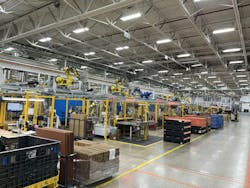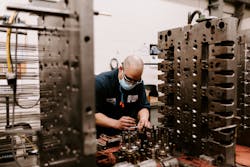By Karen Hanna
Across the parking lot from L&L Products’ Romeo, Mich., manufacturing facility, a clinic tends to the health needs of employees and employees’ families.
“We’ve saved countless lives by early detection [of serious health conditions] of our employees, while some of them had to leave by ambulance. Some of these things are not inexpensive, but we genuinely, truly care that our employees are in good health,” said John Babi, VP of Americas at L&L Products, who lauds the company’s approach toward its employees.
L&L Products — which combines expertise in both materials science and advanced engineering to create custom-engineered solutions that sometime use plastics as a carrier — is a company that prides itself on science. But it’s the chemistry within its workforce that has catalyzed its success, according to executives.
“Culture is the number one thing we work on. The basis of our culture is family,” President Tom Kleino said in a Manufacturing Institute (MI) report, “The Role of Culture and Employee Engagement.”
For manufacturers that are struggling to find new workers, Kleino and Babi’s sentiments might offer a roadmap. Human resources (HR) experts and manufacturing executives say companies that can create an environment of respect, trust and care will have better success holding onto their workers, and bringing new people into the fold won’t be as challenging.
“If you can retain your people, you’re going to be more attractive to a new recruit because they’re going to tell other people what a great workplace you are. Your current employees are your secret weapon to get more good recruits, if you’ve created an environment that they want to keep coming back to,” said Kathleen Quinn Votaw, CEO of TalenTrust, a strategic recruiting and human capital consulting firm that works with manufacturers.
High stakes
While retention strategies — which often include investments in pay, bonuses and other perks — can be expensive, HR experts say the benefits outweigh the costs.
Of particular concern to Julie Davis, VP of people strategy at the Association of Equipment Manufacturers (AEM), are younger workers. They’re more likely to hit the exits if the work culture is a poor fit.
“The average 35-year-old or younger person is staying at a job for 2.8 years,” Davis said. “And I say to manufacturers: The first year, they’re learning their job. The second year, they’re learning their company. By the third year, they’re saying, ‘What is this company going to do for me when it comes to career advancement [and] development?’ If you don’t have an answer for them, 2.8 years, they’re leaving. Because they’re going to go find that next development opportunity for themselves, and they’re committed to their personal development.”
According to Mike Campanella, the president and CEO at Prevue HR Systems, companies on average spent around $5,000 to offset the loss of an hourly worker and the equivalent of six to 12 months of the annual income of a salaried worker.
But the loss goes beyond dollars and cents, he said.
“The indirect costs of turnover, which is lost opportunity, the negative impact they have on your organization or your customers, there’s the whole concept of how they affect other employees with negativity,” he said.
Family first
Retention is a “business imperative,” said Bob Hersh, national managing principal of manufacturing.for Grant Thornton’s New York and New England business advisory services. For him and other experts, the first priority is establishing relationships.
Quinn Votaw was direct in describing what that means for employees’ expectations of their employers: “They just want to matter. They want you to give a s--- about them and their families.”
The MI report, released in September, underscores the influence of culture and relationships on workers’ tenure. Among the takeaways:
• All respondents said they would leave their current job for better pay.
• More than 96 percent of employees said they stay at their current company because of their relationships with colleagues, including co-workers and managers.
• “Family-friendly” topped the characterizations provided by both business leaders and employees in describing their company culture.
• But, while 83 percent of manufacturing leaders said their company had a strong culture, 9.6 percent admitted their company did not. More than 7 percent were uncertain.
Nice enough for your loved ones
Babi initially demurred when Kleino offered to promote him to director of operations six years ago. To become more comfortable with the full range of L&L Products’ operations, Babi insisted on being able to work for a while on the production floor. He still does.
"I said, ‘OK, Tom, I know nothing about anything about this, so you need to let me work on the floor to learn the processes.’ And that was my mindset going in: Learn the process. But what I got was more than just process. I built these relationships on the floor, that have been, honestly, life-changing,” Babi recalled. “... I was going out there to learn processes, and I learned a lot about people.”
The exercise has helped him learn firsthand about the processes the company uses to develop solutions — some involving plastics — for products that exhibit better performance when dealing with issues such as acoustics and vibration. But it also exposes him to the experiences of people at various levels of the company.
A tour of the plant with the company’s CEO and chairman provided one of the most impactful lessons, when, while walking the plant with Babi, he remarked that one area seemed louder than usual. Babi responded that the noise didn’t exceed thresholds set by the U.S. Occupational Safety and Health Administration.
According to Babi, the executive said that wasn’t the point. The company should strive for an environment that’s not just safe for workers, but comfortable and pleasant.
“The new standard is, ‘Do I want my wife/daughter/loved one/spouse in this environment?’ ” Babi said.
Personal touch
“You really have to become a ‘best place to work,’ ” TalenTrust’s Quinn Votaw said. “And I don’t mean that from a marketing perspective. You don’t need to win an award with a magazine, you need to really focus on your internal customer, who is your employee.”
Plant leaders need to engage with their workers, said Shari Nelson, HR director for Hoffer Plastics. Like other HR experts, she stressed the importance of communication.
“I think it’s also very important to be able to walk the plant and just know each individual person,” she said. “Something as simple as knowing someone’s name can go such a long way, and then building on that relationship and getting to know their story and their history. It’s amazing how employees can open up to you if you’re consistent with constantly walking the plant and just getting to know them.”
Family is one of the core values at Hoffer Plastics, said Jeff Klabunde, VP of operations for the South Elgin, Ill., molding shop, which employs about 330 people to make safety closures for flexible pouch packages, along with other products. Being part of the family means having support — both at work, and outside of it.
“Our mission here at Hoffer Plastics is to go all in for people, plastics and purpose,” he said.
Grant Thornton’s Hersh said leaders need sensitivity, to understand that each worker has his or her own needs and experiences.
That requires a “personal touch,” he said.
“You don’t coach teams, you coach individuals,” he said.
Those relationships outweigh the day’s tasks.
“You’re into it in the long haul, and not just, ‘We’re hiring somebody to do a job. If you leave, I don’t care.’ You’ve got to show that interest over the long term,” Hersh said. “And I think that’s how you really establish the stickiness and the retention.”
Long-term benefits
L&L Products has become a “best place to work” — for two years in a row, it’s garnered Top Workplace honors from the Detroit Free Press. But the spirit of openness that pervades L&L Products does more than help employees feel they belong — it allows good ideas to percolate at all levels of the company’s 550-person workforce.
“It’s nonstop,” Babi said.
Every month, focus groups formed based on the month of employees’ hire date meet to discuss ideas for improvement; leaders are present to answer questions, and they leave with a list of actions that are then tracked. Separately, one employee each month is assigned to discuss his or her own connection to the company’s values, which include honesty and respect; consistency and fairness; the obligation to listen; and pride in belonging.
The company also has used the anonymous results collected in the Top Workplace competition to get a handle on its culture, HR Director Jay Krawczyk said.
In addition to the meetings and surveys, the company uses whiteboards — referred to in the lingo of lean, or continuous improvement, as Gemba boards — to solicit input. They’re displayed on all five floors of the plant, so employees can provide suggestions on the spot, as the inspiration strikes.
A recent suggestion to use a different kind of glove resulted in cost savings, once employees had a chance to research the implications of the various options, Babi said.
“Our boards are constantly being filled and renewed with new ideas. It’s a barometer for us for engagement,” Kleino said in the MI report.
“I’ve never seen a company like this communicate so well,” Babi said.
Choosing incentives with care
HR experts offer many suggestions for improving retention — from offering childcare to tying bonuses to company performance. But whether conventional or creative, retention incentives start with concern for employees.
“I think the bottom line always comes down to being in communication with your employees. At every level, people are people, and they deserve a little bit of time and investment and conversation. I think that part of leadership is getting to know your team and being in conversation with your team,” AEM’s Davis said.
Retention strategies can start with the job itself — but they don’t have to end there.
Companies need to look out for employees’ present, as well as their future, according to a Grant Thornton blog post, “New Workforce Strategies in Manufacturing,” published in June. They should highlight the value that employees bring to the job and create a sense of pride in that work, while laying out for them a path to move ahead.
“It’s important to make employees feel happy in their current positions, but many also want to pursue bigger responsibilities, new skills, or simply more money. Clearly set out the steps that employees can take, to help retain these ambitious workers,” the post advises.
With the explosion of work-from-home options, Quinn Votaw expressed particular concern that manufacturers balance the demands of rigid production schedules with employees’ need for flexibility.
Finding a way to do so just might come down to a conversation: “It needs to be, ‘What is meaningful to my workforce? And then how can I potentially make that happen?’ ” Quinn Votaw said.
She’s already seen companies accommodate their workers in unique ways. In one case, a plumbing company that has used TalenTrust’s services developed a huge library of personal improvement classes for its workers — everything from personal finance to parenting. The program is hugely popular, Quinn Votaw said.
“The baseline is how to be the best plumber, and then how to be the best person you can possibly be,” she said.
Motivated by concern for their workforce families, leaders at Hoffer Plastics and L&L Products also are continuing to find ways to improve their culture.
For L&L Products, it’s meant expanding the clinic’s offerings to include counseling services to help employees and their families deal with stresses amplified in the wake of the COVID-19 pandemic.
For Hoffer Plastics, which in early November was preparing for a job fair, it’s meant reaching out to the community, including partner organizations, such as Pads of Elgin Inc., which provides temporary and emergency housing.
Hoffer’s Nelson said, if her company can find the right people, it has the culture to keep them.
“It can be a challenge, but the good news is once we find those individuals, they tend to stay,” she said.
No company can offer everything, or roll out every program at once, Quinn Votaw said. But, with massive numbers of manufacturing job openings projected over the coming years, every company has incentive to start.
“Don’t try to do it all at one in one bite,” she said. “Start small and then grow from there. That would be my advice to the naysayers who are like, ‘Hey, I just have 40 people, 20 people, I can’t afford it.’ I am telling you, they can’t afford not to in this marketplace, where there’s 9.6 million jobs and only 6 million people to fulfill them.”
Contact:
Association of Equipment Manufacturers, Milwaukee, 414-272-0943, www.aem.org
Grant Thornton LLP, Boston, 617-723-7900, www.grantthornton.com
Prevue HR Systems Inc., Vancouver, British Columbia, 888-277-3883, www.prevuehr.com
TalenTrust, Denver, 303-838-3334, www.talentrust.com
About the Author
Karen Hanna
Senior Staff Reporter
Senior Staff Reporter Karen Hanna covers injection molding, molds and tooling, processors, workforce and other topics, and writes features including In Other Words and Problem Solved for Plastics Machinery & Manufacturing, Plastics Recycling and The Journal of Blow Molding. She has more than 15 years of experience in daily and magazine journalism.






